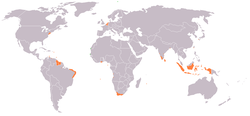
Back Keurajeuën Beulanda ACE Nederlandse Ryk Afrikaans الإمبراطورية الهولندية Arabic هولند ایمپیراتورلوغو AZB Калоніі Нідэрландаў Byelorussian ওলন্দাজ ঔপনিবেশিক সাম্রাজ্য Bengali/Bangla Impalaeriezh trevadennel an Izelvroioù Breton Imperi neerlandès Catalan Nizozemská koloniální říše Czech Niederländische Kolonien German
Dutch Empire | |
|---|---|
|
Flag | |
 An anachronous map of the Dutch colonial Empire. Light green: territories administered by or originating from territories administered by the Dutch East India Company; dark green the Dutch West India Company.
Countries today |
The Dutch Empire owned several territories that were in control by the Dutch Republic (also known as the United Provinces). The Dutch had created colonial empires. These were similar to Portugal and Spain. The Dutch Empire used their skills in shipping and trade with other empires. However, they were trying to be independent from Spain. With the British, the Dutch first built up colonies. The colonies were based on state capitalist corporate colonialism. This was done by the Dutch East and West India companies. The Dutch explored and went on voyages. Some of these were led by Willem Barents, Henry Hudson and Abel Tasman. These men found new places for Europeans.
The Dutch naval power were getting bigger. The Netherlands became the dominated global commerce during the second half of the 17th century. This was called the Dutch Golden Age. The Netherlands lost many colonials and its global power to the British. This happened when the metropole fell to French armies during the Revolutionary Wars. The rest of the Dutch Empire (such as the Dutch East Indies) were in control of the Dutch until the decline of European imperialism following World War II.
Today, the Netherlands are part of a federacy called the Kingdom of the Netherlands. These countries, the Netherlands, Aruba, Curaçao, and Sint Maarten are part of the Kingdom of the Netherlands.
